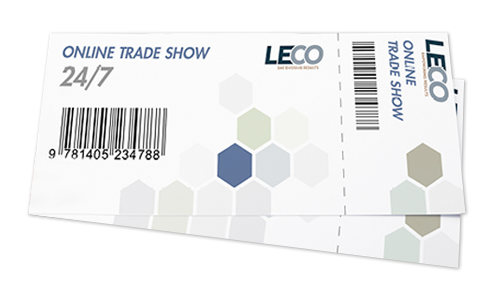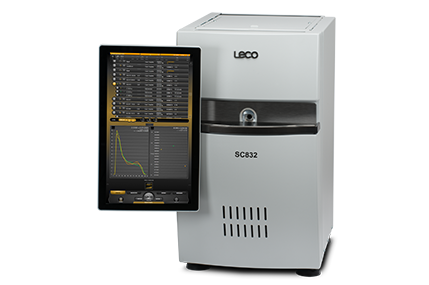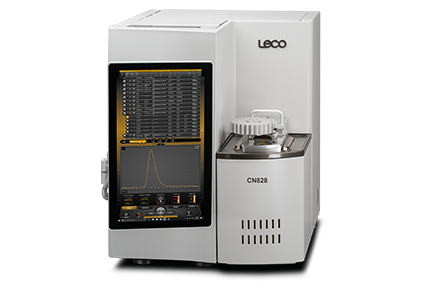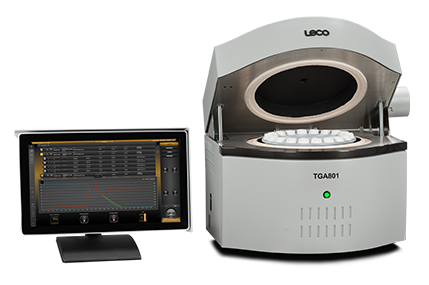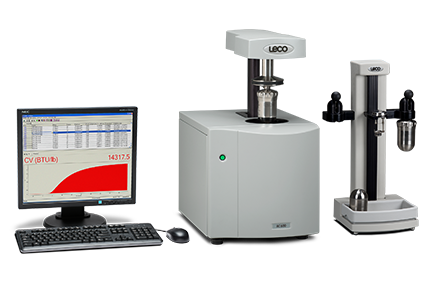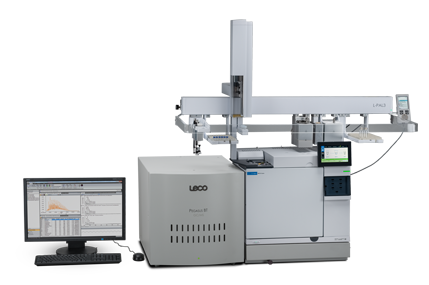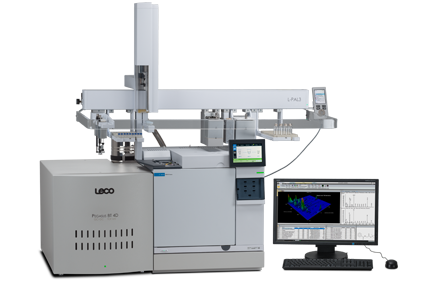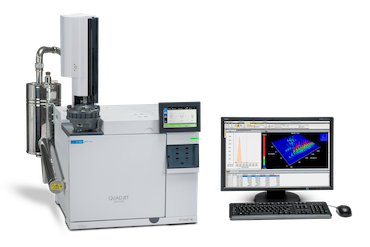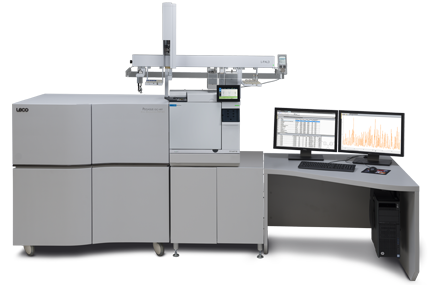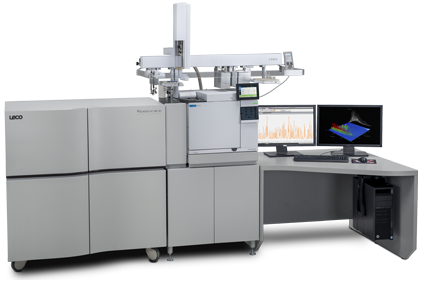
 LECO
Empowering Results
LECO
Empowering Results
Afficher les éléments par tag : Carburant
Explore the Fascinating World of Separation Science
The very first GC-MS was a GC-TOFMS which was built in 1947. The information it provided was much too large to record, and it was not until the mid-1990s when LECO introduced the first fast GC-TOFMS, that GC-TOFMS became a useable tool for researchers and analysts. Followed a few years later by LECO’s introduction of the first GC×GC-TOFMS.
Today, LECO’s Separation Science products are recognised across the globe as leading advanced technology innovations in TOFMS Mass Spectrometry and Comprehensive two-dimensional Chromatography.
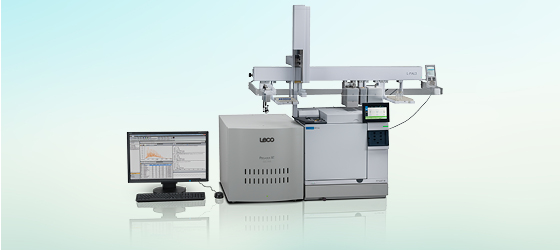
PEGASUS® BT GC-TOFMS
GC Time-Of-Flight Mass Spectrometer
Today‘s laboratories are being asked for more everyday – more samples run, more data acquired, more chemical information processed, and more results achieved – all in less time, for less money. ...
The Pegasus BT allows you to achieve all you need from a single sample run, while powerful and user-friendly ChromaTOF® software processes your data and removes the guesswork involved with analyte identification, quantitation, and reporting. The Pegasus BT gives users more uptime, better data, and an increase in overall productivity and efficiency.
Le spectromètre de masse à temps de vol (time-of-flight mass spectrometer, TOFMS) est idéal pour découvrir de nouveaux composés dans votre échantillon, pour quantifier des composés ciblés dans des échantillons complexes et pour augmenter le rendement car compatible avec la "fast GC".
► Download the free whitepaper and brochure
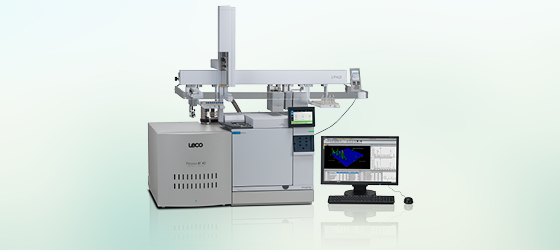
PEGASUS® BT 4D GCxGC-TOFMS
GC×GC Time-Of-Flight Mass Spectrometer
The Pegasus BT 4D offers enhanced sensitivity by coupling our benchtop Pegasus BT with a high-performance GC×GC modulation system. This combination gives the Pegasus BT 4D the ability to interrogate challenging samples ...
... where the best sensitivity is needed. Des fonctionnalités logiciel et instrument uniques et puissantes simplifient la quantification, ainsi que l’utilisation et la compréhension de la GCxGC. Our thermal modulation system, the QuadJet™, is recognised as the gold standard in GC×GC modulation, providing the highest sensitivity available on the market - ideal for analysing the most complex samples.
One of the main advantages of LECO’s GC×GC-TOFMS is its ability to provide vastly improved peak capacity and resolution than traditional GC-MS systems. It also offers comprehensive information about the sample by separating compounds based on two different properties (volatility and polarity). Combining GC×GC with TOFMS is an ultimate solution for the analysis of complex samples.
► Download the free brochure
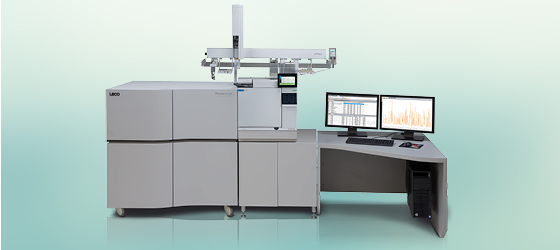
PEGASUS® GC-HRT+
High Resolution Time-Of-Flight Mass Spectrometer
Now with even more sensitivity than ever before, the Pegasus GC-HRT+ is the perfect tool for meeting the challenges of today’s highly complex analytical demands. ...
This high-resolution mass spectrometer features industry leading mass accuracy, full mass range acquisition with exceptional speed, full mass range acquisition with exceptional speed, isotopic abundance and mass resolution, all available in a single injection.
Folded Flight Path® (FFP®) technology and a novel data acquisition system enables simultaneous resolutions of over 50,000 FWHM, mass accuracies less than 1 ppm, and acquisition rates up to 200 spectra/second, without the need to adjust tuning or parameters. Thus, facilitating rich analyte finding and high-confidence analyte identification.
► Download the free brochure
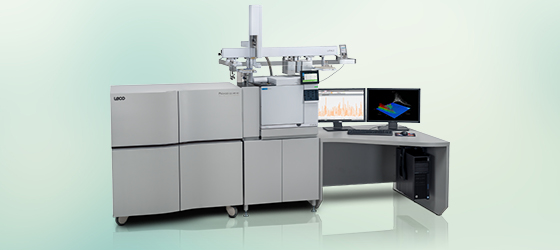
PEGASUS® GC-HRT+ 4D
HR GC×GC Time-Of-Flight Mass Spectrometer
The Pegasus GC-HRT+ 4D combines the highest performance GC×GC and TOFMS tools on the market with High Resolution Deconvolution® (HRD®). Ideal for the most complex samples, ...
... users are able to find more analytes than ever before and confidently identify unknown components.
The Pegasus GC-HRT+ 4D takes advantage of four dimensions of separation and resolution:
- 1st dimension chromatographic resolution
- 2nd dimension chromatographic resolution
- High mass resolution and exceptional mass accuracy
- High Resolution Deconvolution (HRD) from the leaders in deconvolution
ChromaTOF brand software, designed specifically for HRT+ instrumentation and GC×GC support, adds advanced qualitative and quantitative capabilities to an all-in-one user-friendly data system.
► Download the free brochure
Examples of LECO Separation Science Applications
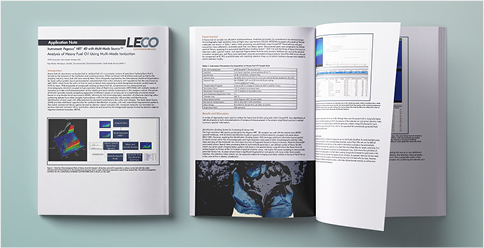
Pétrole
Comprehensive Two-Dimensional Gas Chromatography (GC×GC) has proven to be an extremely valuable analytical technique for the petroleum industry due to its ability to substantially increase the chromatographic peak capacity beyond that of traditional single-dimension gas chromatography. Pairing GC×GC with Time-of Flight Mass Spectrometry (TOFMS) provides unsurpassed characterization capabilities due to the separation power of GC×GC and the ability of TOFMS to provide rich data.
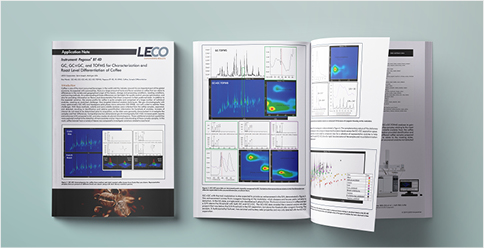
Food Testing
The characterization and safety testing of food and food constitutions can be extremely challenging depending on the complexity and the matrix. The LECO GC×GC TOFMS technology provides a highly powerful separation and remarkable identification allowing for improved workflows. More insights thanks to the advanced technology in combination with LECO’s ChromaTOF® brand software deconvolution algorithm and advanced data analysis tool will improve your Food Quality & Safety Testing and Food R&D. Here we demonstrate the aroma analsyis of two types of coffee and coffee packaging and filter leachates.
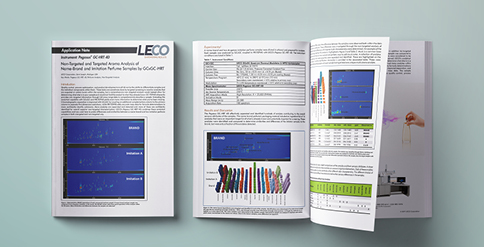
Perfume and Cosmetics
LECO‘s GC×GC-TOFMS is a valuable asset in the production of cosmetics and perfumes that align with Islamic principles. It can be used to identify the ingredients and detect any prohibited substances such as alcohol or non-halal animal-derived ingredients.
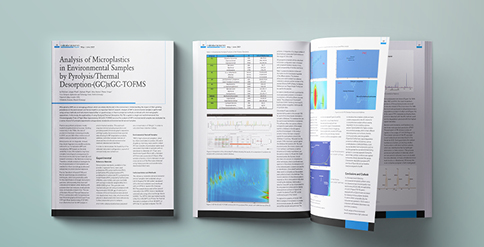
Analyse environnementale
Microplastics are an emerging pollutant which are widely distributed in the environment. Understanding the impact of their growing prevalence on the environment and human health is an important field of research. LECO‘s GC×GC-TOFMS can be used to monitor environmental pollution and air and water quality thus aiding to enforce regulations and ensure the preservation of our environment.

Métabolomique
LECO’s key advantage is the ability to identify and discover more metabolites than other similar technologies. La vitesse de notre acquisition en "full-scan" est incomparable, et si elle est combinée avec la puissance de l'algorithme de déconvolution du logiciel LECO ChromaTOF, permet une caractérisation des métabolomes sans précédent. Nos instruments ont été validés par les chercheurs les plus exigeants du domaine.
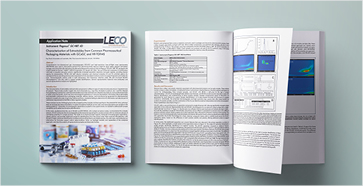
Extractables and Leachables
The characterization of extractable and leachable components from a wide range of materials is an important area of research. Information about extractable and leachable components from packaging and delivery devices for pharmaceutical products is a particular area of growing interest. Analytical testing results on this topic are part of many regulatory submission requirements to the FDA. ...
USP 1663 provides guidance on extractables testing and a variety of analytical approaches can meet compliance. High resolution MS is often considered necessary for identification of unknowns, and sample complexity and low-level detection continue to challenge these analyses. Here, we demonstrate a workflow that uses comprehensive two-dimensional gas chromatography (GC×GC) with HR-TOFMS to help address these challenges.
► App Note | Characterizing Extractables by GC×GC & HR-TOFMS
FAQ – Separation Science
Answer:
Gas chromatography separates components in a mixture by utilizing a thin silica tube coated with a stationary phase. The components, carried by a gas (the mobile phase), move at different speeds based on their affinities for the stationary phase. This differential migration leads to the separation of the components, allowing for their individual analysis and identification.
Alternative response:
- Gas chromatography is a technique for separating a mixture of volatile analytes
- The analytes are transported by a mobile phase (the carrier gas)
- Become distributed between the mobile phase and a stationary phase
- The Stationary Phase is attached to the inside of a very fine column
- Phases are typically characterised by their polarity
- A polar analyte will be retained by polar column for longer than a non-polar analyte
- and vica versa
Answer:
LECO uses Agilent 8890 chromatography. The gas chromatograph includes the following features:
- Compatibility and perfect integration with the mass spectrometer
- Automatic regulation of gas flows
- Agilent supported inlets: Split/Splitless (SSL), Multimode (MMI), Programmable temperature Vaporizer (PTV) etc.
- Programmable oven, up to 450 °C
- Chromatograph compatible with Fast-GC
- The GC is completely controlled by and integrated into LECO’s ChromaTOF software
Answer:
The LECO mass spectrometer is connected to the GC via a heated transfer line. The LECO GC-TOF allows you to have a 'full range' acquisition, without compromise, then a targeted and/or non-targeted data exploitation depending on what you want to do.
It consists of an EI (Electronic Impact) source, a 70 cm flight tube, a reflectron and a detector. Vacuum is provided by an internal turbomolecular pump connected to an external secondary pump.
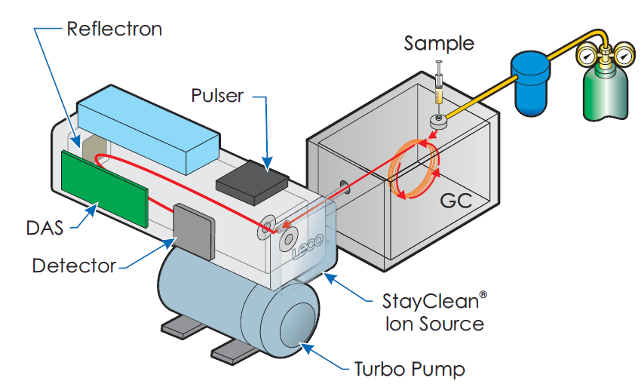
Answer:
The mass range of the Pegasus BT is from 10 to 1500 m/z. All masses are collected all the time, unlike quadrupole instruments that collect a single mass at a time (quadrupole scanning mode is single ion monitoring, SIM, quickly scanning across the mass range).
Answer:
GC×GC-TOFMS can detect discrepancies in the composition of food products, helping to expose fraudulent claims of Halal certification and ensure consumer confidence in authentic Halal products.
Answer:
By examining the chemical composition of inks and pigments, GC×GC-TOFMS provides insights into the materials used in Islamic calligraphy and manuscripts, aiding in their preservation and authentication. An example of similar work can be read in this publication on analysing the paints used by Leonardo Da Vinci.
Answer:
LECO’s GC×GC-TOFMS system utilizes two columns with different separation mechanisms, providing enhanced chromatographic resolution for the analysis of complex mixtures. In one dimension the analytes are separated by polarity, or according to boiling point. An additional dimension separates according to an alternative property, of which there are many. This results in a 3D image – the two dimensions of separation and the abundance of the analytes in the third dimension.
Answer:
LECO's StayClean® ion source originates in the requirement for a fast source to match the speed of the TOFMS. Accomplished by reducing ion to ion interactions, such as with the walls of the source. The source was thus designed without walls – so there is nothing to clean. Massively reduced downtimes, especially for complex matrices and more reproducible results.
Answer:
Yes! With superior separation power and precision, LECO’s GC×GC-TOFMS system can uncover hidden details and confidently identify components, even in the most intricate mixtures:
- Increases detectability
- Removes analytes from matrix interference
- Separates co-elluting peaks
- Creates cleaner peaks, which match closer with libraries
- Creates structured chromatograms thus further improving identification confidence
Answer:
The cryogenic Quad Jet modulator consistently delivers reproducible quantitative results not only within the lab but also between labs worldwide. This is achieved because:
- There are two cold jets. So, eluent from the primary column does not flow into the secondary column by mistake
- The distance between cold zones is identical in every system worldwide, unlike other systems that require manual adjustment and intervention
- The modulation is completely computer controlled. This along with the 2 separate cold zones, allows for variable modulation periods in the same analysis, vastly improving separation across the chromatogram
- In the same way the primary column is temperature controlled in the primary oven, the secondary column is also independently controlled, allowing for total control of the chromatogram along the entire column setup
These four features not only improve separation and control, they are also unique to the LECO QuadJet.
Answer:
By combining comprehensive two-dimensional gas chromatography (GC×GC) with high-speed, high-sensitivity time-of-flight mass spectrometry (TOFMS), LECO's GC×GC-TOFMS can separate and identify the complex mixtures of flavours and fragrances in food samples with detail and precision.
Answer:
Yes! LECO’s GC×GC-TOFMS is an excellent tool for non-intentionally added substances (NIAS) analysis in food safety. It allows for the comprehensive analysis of complex food samples, ensuring the detection and identification of potential contaminants and unwanted substances. For example, LECO’s MOSH/MOAH solution is widely recognised as the most comprehensive and rigorous analyser for mineral oil contamination in food stuffs.
Answer:
LECO’s GC×GC technology utilizes two stages of separation, significantly increasing resolution and analysis power compared to traditional gas chromatography. This allows for the detailed separation and identification of complex mixtures with unparalleled precision.
Answer:
LECO’s TOFMS technology offers excellent sensitivity, speed, and resolution in mass spectrometry. By fragmenting and ionizing analyte molecules and separating the fragments based on their mass-to-charge ratio, LECO's TOFMS enables highly accurate identification and detection of compounds in samples. The system not only records to a computer at high speed, it detects at a rate of 32,000 Hz thus producing a very high level of accuracy.
Answer:
GC×GC-TOFMS enables the analysis of dietary supplements for the presence of non-compliant ingredients, such as animal-derived gelatine, ensuring that the products meet the strict requirements of Halal certification.
Answer:
GC×GC-TOFMS is a valuable tool for monitoring air and soil quality near Islamic sacred sites, identifying pollutants that may pose a risk to their preservation and guiding conservation efforts. As an example, Imperial College London have utilised a LECO Pegasus BT 4D to identify microplastics in the air of London. You can read about it here.
Answer:
LECO’s GC×GC-TOFMS system utilizes Time-of-Flight Mass Spectrometry (TOFMS), which provides high-speed detection of ionized compounds based on their mass-to-charge ratio.
Answer:
LECO provides software for data analysis, enabling compound identification, quantification, and other types of analysis based on the mass spectra obtained from the TOFMS.
Answer:
LECO’s StayClean ion source, a standard feature in every Pegasus BT GC-TOFMS and GC×GC-TOFMS system, flushes neutrals and contaminants continuously. This virtually eliminates the need for routine maintenance, allowing you to spend less time on upkeep and more time on your research.
Answer:
Sample handling is crucial in GC-MS analysis. LECO employs advanced sample handling robots called Autosamplers that can handle samples in three dimensions of space. These robots ensure precise and consistent sample preparation, ranging from simple liquid injections to complex processes like chemical reactions, extractions, and accurate dilutions.
Answer:
The first GC-MS was a GC-TOFMS developed in the 1950s. However, the technique was too powerful for data recording at the time. In the mid-1990s the first GC-TOFMS capable of recording the data for processing was developed by LECO. This breakthrough in fast GC-TOFMS technology allowed researchers and analysts to utilize the capabilities of GC-TOFMS for their analytical needs.
Answer:
By combining two-dimensional separation, robust ionization, and high-speed TOFMS detection, and patented deconvolution algorithms LECO's GC×GC-TOFMS system offers a powerful solution for analysing complex mixtures with enhanced resolution, sensitivity, and separation power.
Answer:
By analysing the chemical composition of materials used in ancient Islamic artifacts, GC×GC-TOFMS assists in determining their authenticity, providing valuable insights into historical and cultural heritage. The chemical composition of such artifacts are extremely complex so utilising multidimensional chromatography techniques with high speed TOFMS, a chemical profile can be created. Furthermore, LECO’s post processing software packages, ChromaTOF Tile and ChromaTOF Sync can identify differences between samples to compare artifacts and identify biomarkers.
Let LECO help you
find the right instruments for your needs.
Si vous souhaitez en savoir plus sur nos produits et solutions pour l’analyse de produits agroalimentaires, réservez un billet gratuit pour notre salon virtuel ou programmez une démonstration en ligne pour avoir un aperçu plus précis de nos instruments.
Explore the Fascinating World of Separation Science
The very first GC-MS was a GC-TOFMS which was built in 1947. The information it provided was much too large to record, and it was not until the mid-1990s when LECO introduced the first fast GC-TOFMS, that GC-TOFMS became a useable tool for researchers and analysts. Followed a few years later by LECO’s introduction of the first GC×GC-TOFMS.
Today, LECO’s Separation Science products are recognised across the globe as leading advanced technology innovations in TOFMS Mass Spectrometry and Comprehensive two-dimensional Chromatography.

PEGASUS® BT GC-TOFMS
GC Time-Of-Flight Mass Spectrometer
Today‘s laboratories are being asked for more everyday – more samples run, more data acquired, more chemical information processed, and more results achieved – all in less time, for less money. ...
The Pegasus BT allows you to achieve all you need from a single sample run, while powerful and user-friendly ChromaTOF® software processes your data and removes the guesswork involved with analyte identification, quantitation, and reporting. The Pegasus BT gives users more uptime, better data, and an increase in overall productivity and efficiency.
Le spectromètre de masse à temps de vol (time-of-flight mass spectrometer, TOFMS) est idéal pour découvrir de nouveaux composés dans votre échantillon, pour quantifier des composés ciblés dans des échantillons complexes et pour augmenter le rendement car compatible avec la "fast GC".
► Download the free whitepaper and brochure

PEGASUS® BT 4D GCxGC-TOFMS
GC×GC Time-Of-Flight Mass Spectrometer
The Pegasus BT 4D offers enhanced sensitivity by coupling our benchtop Pegasus BT with a high-performance GC×GC modulation system. This combination gives the Pegasus BT 4D the ability to interrogate challenging samples ...
... where the best sensitivity is needed. Des fonctionnalités logiciel et instrument uniques et puissantes simplifient la quantification, ainsi que l’utilisation et la compréhension de la GCxGC. Our thermal modulation system, the QuadJet™, is recognised as the gold standard in GC×GC modulation, providing the highest sensitivity available on the market - ideal for analysing the most complex samples.
One of the main advantages of LECO’s GC×GC-TOFMS is its ability to provide vastly improved peak capacity and resolution than traditional GC-MS systems. It also offers comprehensive information about the sample by separating compounds based on two different properties (volatility and polarity). Combining GC×GC with TOFMS is an ultimate solution for the analysis of complex samples.
► Download the free brochure

PEGASUS® GC-HRT+
High Resolution Time-Of-Flight Mass Spectrometer
Now with even more sensitivity than ever before, the Pegasus GC-HRT+ is the perfect tool for meeting the challenges of today’s highly complex analytical demands. ...
This high-resolution mass spectrometer features industry leading mass accuracy, full mass range acquisition with exceptional speed, full mass range acquisition with exceptional speed, isotopic abundance and mass resolution, all available in a single injection.
Folded Flight Path® (FFP®) technology and a novel data acquisition system enables simultaneous resolutions of over 50,000 FWHM, mass accuracies less than 1 ppm, and acquisition rates up to 200 spectra/second, without the need to adjust tuning or parameters. Thus, facilitating rich analyte finding and high-confidence analyte identification.
► Download the free brochure

PEGASUS® GC-HRT+ 4D
HR GC×GC Time-Of-Flight Mass Spectrometer
The Pegasus GC-HRT+ 4D combines the highest performance GC×GC and TOFMS tools on the market with High Resolution Deconvolution® (HRD®). Ideal for the most complex samples, ...
... users are able to find more analytes than ever before and confidently identify unknown components.
The Pegasus GC-HRT+ 4D takes advantage of four dimensions of separation and resolution:
- 1st dimension chromatographic resolution
- 2nd dimension chromatographic resolution
- High mass resolution and exceptional mass accuracy
- High Resolution Deconvolution (HRD) from the leaders in deconvolution
ChromaTOF brand software, designed specifically for HRT+ instrumentation and GC×GC support, adds advanced qualitative and quantitative capabilities to an all-in-one user-friendly data system.
► Download the free brochure
Examples of LECO Separation Science Applications

Pétrole
Comprehensive Two-Dimensional Gas Chromatography (GC×GC) has proven to be an extremely valuable analytical technique for the petroleum industry due to its ability to substantially increase the chromatographic peak capacity beyond that of traditional single-dimension gas chromatography. Pairing GC×GC with Time-of Flight Mass Spectrometry (TOFMS) provides unsurpassed characterization capabilities due to the separation power of GC×GC and the ability of TOFMS to provide rich data.

Food Testing
The characterization and safety testing of food and food constitutions can be extremely challenging depending on the complexity and the matrix. The LECO GC×GC TOFMS technology provides a highly powerful separation and remarkable identification allowing for improved workflows. More insights thanks to the advanced technology in combination with LECO’s ChromaTOF® brand software deconvolution algorithm and advanced data analysis tool will improve your Food Quality & Safety Testing and Food R&D. Here we demonstrate the aroma analsyis of two types of coffee and coffee packaging and filter leachates.

Perfume and Cosmetics
LECO‘s GC×GC-TOFMS is a valuable asset in the production of cosmetics and perfumes that align with Islamic principles. It can be used to identify the ingredients and detect any prohibited substances such as alcohol or non-halal animal-derived ingredients.

Analyse environnementale
Microplastics are an emerging pollutant which are widely distributed in the environment. Understanding the impact of their growing prevalence on the environment and human health is an important field of research. LECO‘s GC×GC-TOFMS can be used to monitor environmental pollution and air and water quality thus aiding to enforce regulations and ensure the preservation of our environment.

Métabolomique
LECO’s key advantage is the ability to identify and discover more metabolites than other similar technologies. La vitesse de notre acquisition en "full-scan" est incomparable, et si elle est combinée avec la puissance de l'algorithme de déconvolution du logiciel LECO ChromaTOF, permet une caractérisation des métabolomes sans précédent. Nos instruments ont été validés par les chercheurs les plus exigeants du domaine.

Extractables and Leachables
The characterization of extractable and leachable components from a wide range of materials is an important area of research. Information about extractable and leachable components from packaging and delivery devices for pharmaceutical products is a particular area of growing interest. Analytical testing results on this topic are part of many regulatory submission requirements to the FDA. ...
USP 1663 provides guidance on extractables testing and a variety of analytical approaches can meet compliance. High resolution MS is often considered necessary for identification of unknowns, and sample complexity and low-level detection continue to challenge these analyses. Here, we demonstrate a workflow that uses comprehensive two-dimensional gas chromatography (GC×GC) with HR-TOFMS to help address these challenges.
► App Note | Characterizing Extractables by GC×GC & HR-TOFMS
FAQ – Separation Science
Answer:
Gas chromatography separates components in a mixture by utilizing a thin silica tube coated with a stationary phase. The components, carried by a gas (the mobile phase), move at different speeds based on their affinities for the stationary phase. This differential migration leads to the separation of the components, allowing for their individual analysis and identification.
Alternative response:
- Gas chromatography is a technique for separating a mixture of volatile analytes
- The analytes are transported by a mobile phase (the carrier gas)
- Become distributed between the mobile phase and a stationary phase
- The Stationary Phase is attached to the inside of a very fine column
- Phases are typically characterised by their polarity
- A polar analyte will be retained by polar column for longer than a non-polar analyte
- and vica versa
Answer:
LECO uses Agilent 8890 chromatography. The gas chromatograph includes the following features:
- Compatibility and perfect integration with the mass spectrometer
- Automatic regulation of gas flows
- Agilent supported inlets: Split/Splitless (SSL), Multimode (MMI), Programmable temperature Vaporizer (PTV) etc.
- Programmable oven, up to 450 °C
- Chromatograph compatible with Fast-GC
- The GC is completely controlled by and integrated into LECO’s ChromaTOF software
Answer:
The LECO mass spectrometer is connected to the GC via a heated transfer line. The LECO GC-TOF allows you to have a 'full range' acquisition, without compromise, then a targeted and/or non-targeted data exploitation depending on what you want to do.
It consists of an EI (Electronic Impact) source, a 70 cm flight tube, a reflectron and a detector. Vacuum is provided by an internal turbomolecular pump connected to an external secondary pump.

Answer:
The mass range of the Pegasus BT is from 10 to 1500 m/z. All masses are collected all the time, unlike quadrupole instruments that collect a single mass at a time (quadrupole scanning mode is single ion monitoring, SIM, quickly scanning across the mass range).
Answer:
GC×GC-TOFMS can detect discrepancies in the composition of food products, helping to expose fraudulent claims of Halal certification and ensure consumer confidence in authentic Halal products.
Answer:
By examining the chemical composition of inks and pigments, GC×GC-TOFMS provides insights into the materials used in Islamic calligraphy and manuscripts, aiding in their preservation and authentication. An example of similar work can be read in this publication on analysing the paints used by Leonardo Da Vinci.
Answer:
LECO’s GC×GC-TOFMS system utilizes two columns with different separation mechanisms, providing enhanced chromatographic resolution for the analysis of complex mixtures. In one dimension the analytes are separated by polarity, or according to boiling point. An additional dimension separates according to an alternative property, of which there are many. This results in a 3D image – the two dimensions of separation and the abundance of the analytes in the third dimension.
Answer:
LECO's StayClean® ion source originates in the requirement for a fast source to match the speed of the TOFMS. Accomplished by reducing ion to ion interactions, such as with the walls of the source. The source was thus designed without walls – so there is nothing to clean. Massively reduced downtimes, especially for complex matrices and more reproducible results.
Answer:
Yes! With superior separation power and precision, LECO’s GC×GC-TOFMS system can uncover hidden details and confidently identify components, even in the most intricate mixtures:
- Increases detectability
- Removes analytes from matrix interference
- Separates co-elluting peaks
- Creates cleaner peaks, which match closer with libraries
- Creates structured chromatograms thus further improving identification confidence
Answer:
The cryogenic Quad Jet modulator consistently delivers reproducible quantitative results not only within the lab but also between labs worldwide. This is achieved because:
- There are two cold jets. So, eluent from the primary column does not flow into the secondary column by mistake
- The distance between cold zones is identical in every system worldwide, unlike other systems that require manual adjustment and intervention
- The modulation is completely computer controlled. This along with the 2 separate cold zones, allows for variable modulation periods in the same analysis, vastly improving separation across the chromatogram
- In the same way the primary column is temperature controlled in the primary oven, the secondary column is also independently controlled, allowing for total control of the chromatogram along the entire column setup
These four features not only improve separation and control, they are also unique to the LECO QuadJet.
Answer:
By combining comprehensive two-dimensional gas chromatography (GC×GC) with high-speed, high-sensitivity time-of-flight mass spectrometry (TOFMS), LECO's GC×GC-TOFMS can separate and identify the complex mixtures of flavours and fragrances in food samples with detail and precision.
Answer:
Yes! LECO’s GC×GC-TOFMS is an excellent tool for non-intentionally added substances (NIAS) analysis in food safety. It allows for the comprehensive analysis of complex food samples, ensuring the detection and identification of potential contaminants and unwanted substances. For example, LECO’s MOSH/MOAH solution is widely recognised as the most comprehensive and rigorous analyser for mineral oil contamination in food stuffs.
Answer:
LECO’s GC×GC technology utilizes two stages of separation, significantly increasing resolution and analysis power compared to traditional gas chromatography. This allows for the detailed separation and identification of complex mixtures with unparalleled precision.
Answer:
LECO’s TOFMS technology offers excellent sensitivity, speed, and resolution in mass spectrometry. By fragmenting and ionizing analyte molecules and separating the fragments based on their mass-to-charge ratio, LECO's TOFMS enables highly accurate identification and detection of compounds in samples. The system not only records to a computer at high speed, it detects at a rate of 32,000 Hz thus producing a very high level of accuracy.
Answer:
GC×GC-TOFMS enables the analysis of dietary supplements for the presence of non-compliant ingredients, such as animal-derived gelatine, ensuring that the products meet the strict requirements of Halal certification.
Answer:
GC×GC-TOFMS is a valuable tool for monitoring air and soil quality near Islamic sacred sites, identifying pollutants that may pose a risk to their preservation and guiding conservation efforts. As an example, Imperial College London have utilised a LECO Pegasus BT 4D to identify microplastics in the air of London. You can read about it here.
Answer:
LECO’s GC×GC-TOFMS system utilizes Time-of-Flight Mass Spectrometry (TOFMS), which provides high-speed detection of ionized compounds based on their mass-to-charge ratio.
Answer:
LECO provides software for data analysis, enabling compound identification, quantification, and other types of analysis based on the mass spectra obtained from the TOFMS.
Answer:
LECO’s StayClean ion source, a standard feature in every Pegasus BT GC-TOFMS and GC×GC-TOFMS system, flushes neutrals and contaminants continuously. This virtually eliminates the need for routine maintenance, allowing you to spend less time on upkeep and more time on your research.
Answer:
Sample handling is crucial in GC-MS analysis. LECO employs advanced sample handling robots called Autosamplers that can handle samples in three dimensions of space. These robots ensure precise and consistent sample preparation, ranging from simple liquid injections to complex processes like chemical reactions, extractions, and accurate dilutions.
Answer:
The first GC-MS was a GC-TOFMS developed in the 1950s. However, the technique was too powerful for data recording at the time. In the mid-1990s the first GC-TOFMS capable of recording the data for processing was developed by LECO. This breakthrough in fast GC-TOFMS technology allowed researchers and analysts to utilize the capabilities of GC-TOFMS for their analytical needs.
Answer:
By combining two-dimensional separation, robust ionization, and high-speed TOFMS detection, and patented deconvolution algorithms LECO's GC×GC-TOFMS system offers a powerful solution for analysing complex mixtures with enhanced resolution, sensitivity, and separation power.
Answer:
By analysing the chemical composition of materials used in ancient Islamic artifacts, GC×GC-TOFMS assists in determining their authenticity, providing valuable insights into historical and cultural heritage. The chemical composition of such artifacts are extremely complex so utilising multidimensional chromatography techniques with high speed TOFMS, a chemical profile can be created. Furthermore, LECO’s post processing software packages, ChromaTOF Tile and ChromaTOF Sync can identify differences between samples to compare artifacts and identify biomarkers.
Let LECO help you
find the right instruments for your needs.
Si vous souhaitez en savoir plus sur nos produits et solutions pour l’analyse de produits agroalimentaires, réservez un billet gratuit pour notre salon virtuel ou programmez une démonstration en ligne pour avoir un aperçu plus précis de nos instruments.
Solutions LECO pour l’analyse de l’énergie et des carburants
L’expansion, la conservation et la prolongation de nos ressources énergétiques limitées signifient que les entreprises devront être en mesure d’analyser de nouvelles sources ainsi que de valider la qualité des approvisionnements existants. Les instruments LECO permettent aux entreprises énergétiques de se conformer aux réglementations environnementales de plus en plus strictes.
Bien que LECO continue d’être un chef de file en matière d’essais carbone/soufre du charbon et du coke, elle a depuis élargi son champ d’action aux biocarburants, à la biomasse, aux additifs pour huiles, et au carburéacteur. Au fur et à mesure que ces ressources deviennent plus précieuses, la technologie LECO est là pour valider leur potentiel et leur qualité, tout en vous aidant à respecter les réglementations gouvernementales.
Product portfolio
Tap into the power of cutting-edge technology. Our instruments excel in characterizing even the most intricate mixtures, enabling precise determination and ultimate analysis. Gain invaluable insights for e. g. calculating material/energy balances, optimizing efficiencies, and assessing emissions potentials. Experience the pinnacle of accuracy and efficiency in energy and fuels analysis with our advanced solutions.
Parcourez notre gamme de produits analytiques scientifiques pour l’analyse de l’énergie et des carburants afin de trouver l’instrument approprié à vos besoins spécifiques.
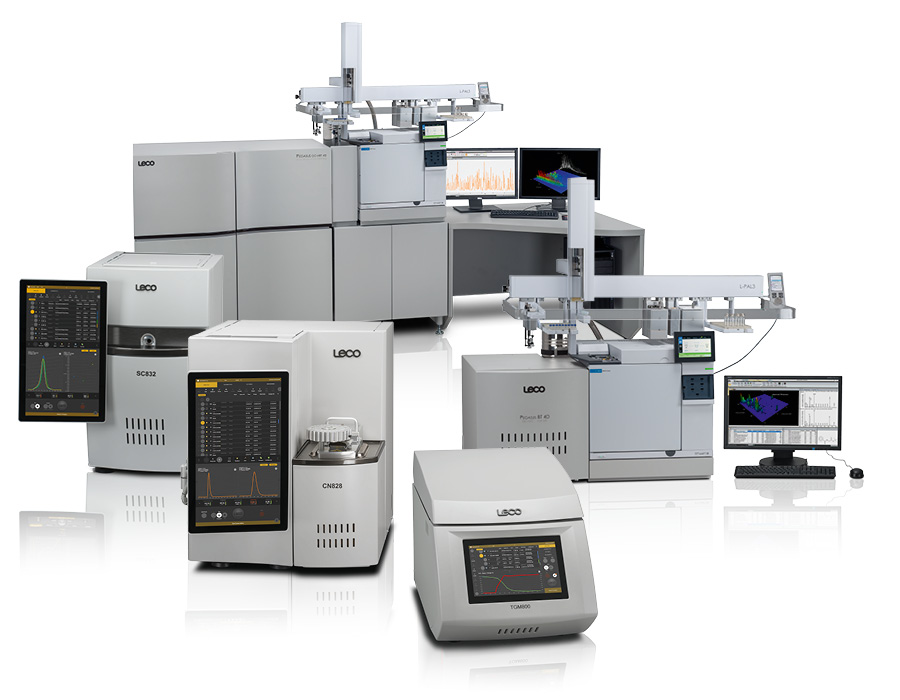
Soufre et Carbone SC832
La série 832 de déterminateurs élémentaires de LECO est spécialement conçue pour effectuer l’analyse du carbone et du soufre du charbon, du coke, des lubrifiants, des mazouts et de beaucoup d’autres matériaux, organiques et inorganiques pour certains. La série 832 est une ressource précieuse pour tout laboratoire nécessitant une analyse rapide et précise des combustibles solides.
CHN828 Analyse élémentaire carbone/hydrogène/azote
La série CHN828 permet d’obtenir des résultats rapides dans les matrices organiques allant des aliments aux carburants. Le système de four à deux étages fonctionne à des températures allant jusqu’à 1 050 °C avec un environnement d’oxygène exclusif assurant la combustion complète de tous les échantillons organiques, sans nécessiter de réactifs oxydants métalliques supplémentaires ou d’autres gaz porteurs. La capacité de masse de macro-échantillons associée à des temps de cycle allant jusqu’à 4 minutes fait du CHN828 l’instrument idéal pour une base d’applications diverses, tout en offrant un débit inégalé.
TGA8O1 Humidité/Cendres/Matières volatiles
Le TGA801 est votre solution complète pour une analyse macro-thermogravimétrique rapide et robuste des constituants. Déterminez la perte de poids en tant qu’humidité totale, cendres, teneur en matières volatiles ou perte au feu dans divers matériaux organiques, inorganiques et synthétiques. Le TGA801 est parfait pour une variété d’industries et d’applications - y compris les aliments pour animaux, les produits de broyage, les aliments, les catalyseurs, le charbon/coke et le ciment.
AC600 Calorimètre semi-automatique
L’AC600 est un calorimètre Isoperibol qui fournit des résultats calorifiques rapides et précis pour divers matériaux organiques tels que le charbon, le coke, les fiouls et les déchets. Sa conception unique combine une technologie matérielle et logicielle de pointe avec des fonctionnalités d’automatisation et ergonomiques pour améliorer les performances et le débit de l’instrument.
PEGASUS® BT GC-TOFMS
La fiabilité et la durabilité éprouvées de notre marque Pegasus dans une unité de paillasse pratique vous offrent plus de disponibilité, des données chimiques améliorées et une augmentation de la productivité et de l’efficacité globales.
PEGASUS® BT 4D GCxGC-TOFMS
La fiabilité et la durabilité éprouvées de notre marque Pegasus dans une unité de paillasse pratique vous offrent plus de disponibilité, des données chimiques améliorées et une augmentation de la productivité et de l’efficacité globales.
QuadJet™ SD
Le QuadJet™ SD de LECO est la solution idéale pour les échantillons qui arrivent dans votre laboratoire. En combinant la sensibilité du détecteur à ionisation de flamme (FID) avec la résolution chromatographique accrue de la chromatographie en phase gazeuse bidimensionnelle intégrale (CGxCG), le QuadJet SD fournit une meilleure analyse des composés présents dans votre échantillon qu’une analyse GC simple. Aucun autre système disponible sur le marché ne peut offrir la même réduction de bruit et d’erreur que le QuadJet SD.
Pegasus® GC-HRT+ (TOFMS haute résolution)
La technologie de spectromètre de masse à temps de vol (TOFMS) haute résolution offre des capacités MS hautes performances, notamment la vitesse d’acquisition, la précision de la masse, l’abondance isotopique relative précise, la résolution de la masse et la plage dynamique, toutes disponibles simultanément. Conçu pour le laboratoire de R&D pour plonger profondément dans les échantillons de produits pétrochimiques et résoudre des matrices complexes.
PEGASUS® GC-HRT+ 4D
Le Pegasus GC-HRT+ 4D de LECO offre aux utilisateurs la capacité sans précédent d’étudier les échantillons de pétrole les plus complexes et d’identifier les analytes inconnus. Trouvez plus d’analytes que jamais grâce à la déconvolution haute résolution® (HRD®) et à la chromatographie GC × GC complète.
Energy & Fuels Publication Library
Explore the depths of energy and fuels analysis with LECO. Dive into our informative eBook and discover a wealth of Application Notes covering mass spectrometry, thermal analysis, and elemental analysis in the field of energy and fuels. Gain valuable insights by filling out our form to access and download the eBook today.
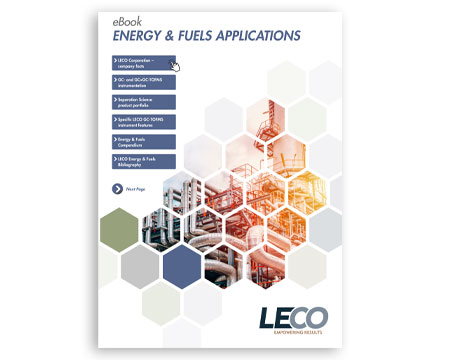
eBook Applications énergie et carburants
Livre électronique interactif pour les applications d’énergie et de carburants
par LECO Europe B.V.
Please complete our form to download the eBook ...
Brochure LECO Solutions for Energy & Fuels Analysis"
LECO Brochure in A4 format for the “Energy & Fuels” market
par LECO Europe B.V.
Please download the Brochure ...
If you want to learn more about our products and solutions for energy & fuels analysis, book a free ticket to our Virtual Trade Show, or schedule an online demo for a deeper insight in our instruments.
Wollen Sie Ihre Dumas-Analyse revolutionieren?
Dann brauchen Sie die richtige Lösung.
Durch die Integration modernster Hardware und unserer Touchscreen-Softwareplattform können Sie mit der 828 SERIE oder 928 SERIE eine Vielzahl von Probenanalysen erledigen. Die Vorteile und Leistungsmerkmale früherer Generationen von LECO Makro-Verbrennungsgeräten wurden beibehalten, während Durchsatz, Verfügbarkeit und Zuverlässigkeit entscheidend verbessert wurden. Alle Modelle der Serie 828 sind mit dem S832-Add-on kompatibel und ermöglichen eine separate Schwefelbestimmung. Makroprobenanalytik und Zykluszeiten von nur 2,8 Minuten machen die 828-Serie und 928-Serie zur idealen Lösung für eine Vielzahl von Anwendungen und bieten einen beispiellos hohen Probendurchsatz. Die unerreichten Makro-Fähigkeiten der 928 Serien mit den großen Verbrennungsschiffchen für feste und flüssige Proben stehen ebenso zur Verfügung.
Lassen Sie sich noch heute beraten!
Wir unterstützen und beraten Sie in allen Fragen rund um Dumas-Analysatoren wie auch Feuchte- und Ascheanalysen in Lebensmitteln und vielen weiteren Matrices.
Wir freuen uns auf Ihre Anfrage!

Sie möchten einen Dumas-Analysator, der …

... von 20 Servicetechnikern unterstützt wird, allein im Raum DACH/Benelux.

... eine korrekte Schwefelanalytik durch Hochtemperatur-Verbrennung liefert, auch mit 100% Recoveryrate.

... eine Reduktionschemikalien-Standzeit bis zu 4.000 Analysen hat, völlig egal was Sie analysieren.

... günstigste, laufende Kosten bei geringstem Wartungsaufwand bietet.

... eine kompromisslose Verbrennung in reinem O2 bietet ohne jede Matrix Abhängigkeit und weitere Infos über die Probe.

... schnelle Analysenzeiten bietet und auch im CHN / CHNS Modus nur ca. 5 Minuten benötigt.

... einen niedrigen Helium- / Argon-Verbrauch hat (1 Flasche ≈ 5.000 Analysen).
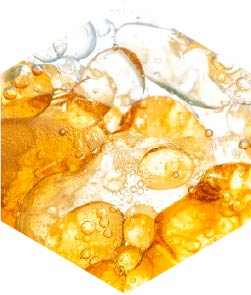
... Flüssigkeiten einfach ohne Zusatzmaterialien einwiegen kann.
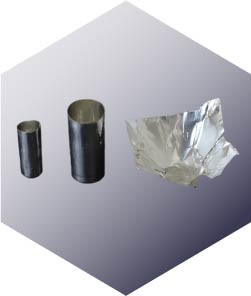
... kleine Kapseln, Folien und Gelkapseln sowie großvolumige Verbrennungstiegel flexibel verwenden kann (CHNS828).
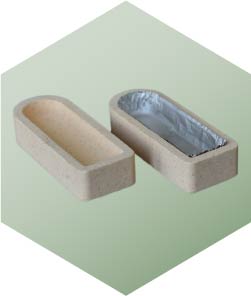
... ein traditionelles System mit Kapseln / Folien nutzt und eines mit großvolumigen Verbrennungsschiffchen (CNS928).

... die Trocknung der Gase mit einem hocheffizienten Thermokühler durchführt ohne weiteres Trägergas. Gilt nicht für H- und S-Varianten sowie CNS928.
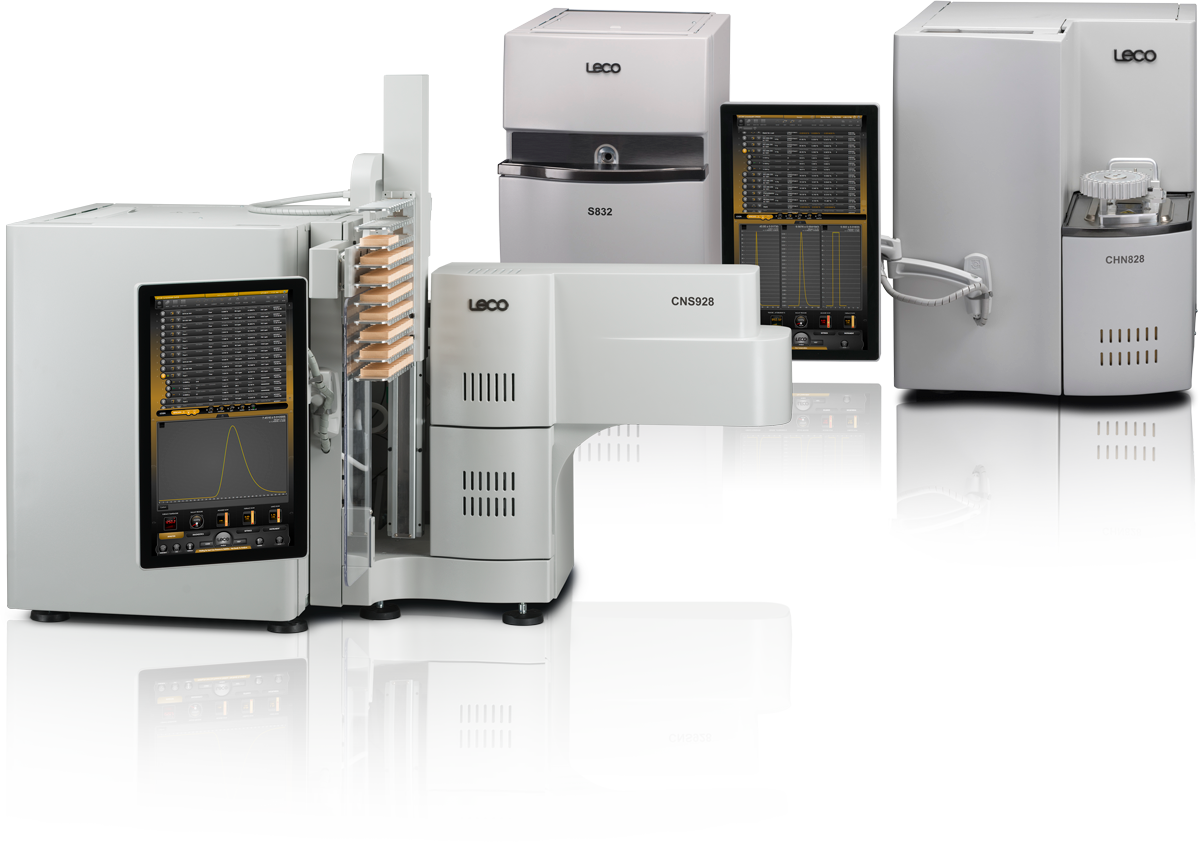
CHNS828 & CNS928 Serie – Vorteile und Merkmale
- Unerreichter Probendurchsatz optimiert Laborproduktivität
- Kurze Zykluszeiten von nur 2,8 Minuten für höchste Produktivität der FP/CN-Modelle
- Längere Lebensdauer der Reagenzien für eine optimale Betriebszeit des Geräts
- Einfacher Zugang zu üblichen Wartungsarbeiten reduziert deutlich Standzeiten und Dauer routinemäßiger Wartungsarbeiten
- Ergonomisches, bedienerzentriertes Design mit frei schwenkbarem Touchscreen
- Widerstandsfähiger Autoloader für 30 Proben mit optionaler Erweiterung auf 120 Proben maximiert die Laboreffizienz
- Verbesserte Ofeneffizienz und Zuverlässigkeit dank reagenzienfreiem Design
Kontaktieren Sie uns
ÜBERZEUGEN SIE SICH VON DER QUALITÄT UNSERER PRODUKTE
Lassen Sie sich von den LECO Experten unsere Produkte demonstrieren und testen Sie deren Leistungsfähigkeit! Kostenlos und wenn Sie wünschen auch kontaktlos bieten wir Ihnen dafür verschiedene Services an. Buchen Sie z. B. Ihr Ticket für unsere Virtual Trade Show oder vereinbaren Sie einen Termin für eine Online-Demo.




